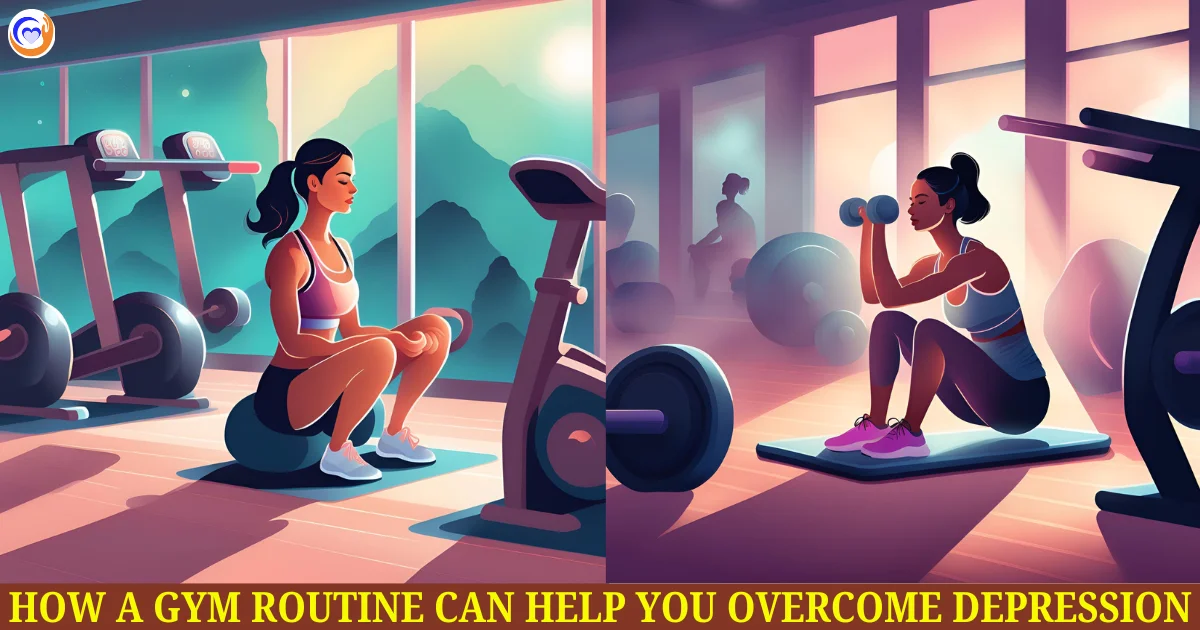Boosting Your Mood: A Gym Routine’s Power Against Depression
I used to think How a Gym Routine Can Help You Overcome Depression of sadness and exhaustion, something that trapped me no matter how hard I tried to get out. It wasn’t until I started a simple gym routine that I began to understand how physical activity could help. Research, like a study from The American Journal of Psychiatry, concluded that even just an hour of exercise each week can prevent up to 12 percent of future cases of depression.
For me, it wasn’t about a cure but about healing. Regular trips to the gym—whether I’d jog on the treadmill or stretch during a yoga class—started releasing those feel-good chemicals called endorphins. They didn’t just ease my worries; they gave my brain a natural lift, making my mind feel lighter and my mood brighter.
What surprised me most was how taking small steps—like walking briskly to the park or climbing stairs instead of using elevators—could improve my well-being. It’s not about being a businessman rushing to an appointment or a homemaker tending to the house; it’s for people from all faces of life, working professionals to kids playing soccer in the field.
A routine doesn’t have to be a big task or a 30-minute block. Even sneaking in activity—like a quick dance to music on the patio or a bike ride by the lake—helps break the negative thoughts that feed anxiety and depression. I’d sweep the sidewalk or mow the lawn with a push mower, and suddenly, I’d stop thinking about my lack of motivation and start feeling a sense of creativity and control.
The gym became my place to move, not just my body but my thoughts too. I’d pick a new exercise each week—maybe martial arts or canoeing with family—and it turned into a lifestyle, not a to-do list to check off. It’s like planting something in a garden; you tend to it daily, and over time, you see growth. Engaging in vigorous workouts or gently stretching everywhere—from the yard to the beach—helps organize your mind, pushing away the strange fog of depression. For me, it was about taking back my future, one step, one rep, one breath at a time, and watching how even a single coffee break walk could shift everything.
I’ve seen it work for others too—an individual team of non-ignorant folks, from the office to the neighborhood, all finding ways to cope. Consider this: a friend who’d rather ride the bus or drive started to walk early in the morning, and soon, she was back to her old self, full of ideas and energy. A gym routine isn’t just for the body; it’s a tool to feed your mental health, releasing endorphins and building a structure that fights sadness. Whether you play tag with children, hike with a dog, or boogie to your favorite tune, it’s about moving forward, daily, and letting that common cycle of worry fade into something else—hope.
Read More: Wellness Health Promotion and Disease Prevention

A Gym Routine: Your Ally in Fighting Depression
I used to feel drained by depression, like a constant wave of sadness and fatigue that left me disrupted and isolated. But then I found energy in something simple: a gym routine. It wasn’t about lifting heavy weights or running for hours—it was about consistency. Setting a schedule, even just walking on the treadmill or stretching in the morning, helps bring structure to my day. That small act of discipline became a natural way to cope, reducing the lack of purpose I felt. Dr. Miller, a name I came across, once said exercise supports nerve cells in the hippocampus—the brain region tied to mood. For me, that growth was real; I started feeling refreshed instead of fatigued.
The gym isn’t just a place—it’s an environment full of like-minded people. I’d nod at a trainer or chat with a workout buddy, and suddenly, the loneliness eased. That social interaction, even if small, was welcoming and encourages a sense of community. It’s notable how these connections improve my self-worth, battling the self-doubt that depression brings. I began setting goals—maybe jogging a bit longer or lifting something lighter—and achieving them gave me a victory, boosting my confidence. Every step felt like taking control, contributing to a positive self-perception that I hadn’t known before.
What’s amazing is how exercise releases feel-good chemicals like endorphins. Neuroscientists say these biological factors spur growth in the brain, relieving depression symptoms. I’d work out—sometimes high-intensity, sometimes low-intensity—and feel the stress and negative cycle breaking. It wasn’t just my mood; my sleep got deeper, regulating my sleep-wake cycle and restoring me throughout the night. Insomnia, a common battle for the depressed, started falling away. Even on days when I felt sad, a quick yoga session or a walk made it easier to stay awake and grounded.
I learned that exercising increases blood circulation and stamina, providing a natural energy boost. It’s not about excessive workouts but finding a pace that works. My Certified Trainers at Anytime Fitness India were efficient, customizing a Training plan that fit me. That supporting team turned a challenging idea into something possible. Physical activity became a healthy outlet, channeling my emotions instead of turning to avoidance behaviors like alcohol or drinking. It’s healthier than manifesting gloom at home—it’s doing something productive, improving my mental health bit by bit.
The benefits go beyond the gym. Helping my heart, lowering pressure, and reducing diabetes risk are bonuses, but the mental recovery is the real value. Exercising acts as a mechanism to battle depression, regulating my body and mind. I’d see joggers report a high, but for me, it was the low-intensity habits—like treadmill time or stretching—that kept me going. It’s simply about showing up consistently, letting the cascade of events unfold, from biological proteins to emotional relief. It’s new, but it’s working.
For many, including me, the gym introduces a way to stay connected and healthy. It’s not just about physical health—it’s mental management. Establishing this routine reduces stress, making me feel lighter and more alive. I’d interact with friends, providing a friendly community that helps restore hope. It’s practically a new option for coping, one that encourages growth and leaves the negative behind. Every small victory matters, and I’m experiencing it firsthand.
Why Exercise Lifts Your Mind: The Science of Mental Health

I’ve always heard people say exercise is good for your body, but it took me a while to understand how it helps your mental health too. Research shows that going to the gym regularly can lower sadness and anxiety, making it a powerful tool for combating depression. Science explains it simply: when we work out, our body releases feel-good hormones like endorphins, serotonin, and dopamine. These are natural neurotransmitters that play a big role in regulating emotions and mood. For me, even a short routine—nothing hard or impossible—started promoting a sense of wellbeing, like a quiet battle against the stress and depression I was struggling with.
It’s not just about feeling good in the moment. Experts suggest that physical activity increases production of these hormones while reducing cortisol, the hormone associated with stress. I noticed this myself—after establishing a gym habit, my sleep got better, and my mind felt sharper, improving my cognitive function. Studies even show that for mild-moderate depression, exercise can be as effective as antidepressants or psychological treatments like behavioural therapy. It’s notable how it reduces the risk of developing mental illness over time, lowering rates of conditions that weigh us down. I didn’t need to wonder anymore; the real-life experiences of taking it one day at a time proved it’s an essential addition to any healthy plan.
What I love most is how it’s a tool we all know about but often overlook. Building a routine doesn’t mean losing weight or muscles—it’s about keeping your mind mentally healthy. Many options exist, from home stretches to gym sessions, and they’re valuable for treating depression physically and emotionally. Now, when sadness or anxiety creeps in, I fight it by getting up and moving, letting my body help my brain find peace. It’s important to suggest this to yourself too—it seems small, but the overall decreases in stress levels and the boost to mood are for real. My idea of therapy shifted; it’s not just talking, it’s working out, and it promotes a better me every day.
Fitness as Your Daily Lift: Blending Exercise into Life

I used to think fitting exercise into my week was overwhelming, especially when depression made every day feel heavy. But then I learned that even 150 minutes of moderate activity—like walking or riding a bike—could help my health. It’s not about losing weight fast; it’s about keeping a balanced routine that reduces anxiety and lifts my mind. I started slowly, aiming for consistency over intensity, and found that small sessions of light movements—like stretching on the treadmill—brought significant benefits. Over time, I’d increase it by 10%, building endurance without overusing my muscles or injuring a joint.
The trick was making it daily. I’d schedule a workout like an appointment, maybe watch my favorite show while walking, or take a break to bike toward the park. It became easier to include exercise when I stopped focusing on huge goals and started enjoying it—like dancing to music or swimming in water. Cross-training kept me from getting bored, mixing low-impact forms with vigorous bursts. I’d try high-intensity intervals—short 10 or 30-second bursts—then recover with slower activity. That variety made it exciting, and I felt my body and emotional health improve without feeling sore or too tired.
Strength training changed things too. Just two sets of exercising major muscle groups each week, using resistance or weightlifting, gave me a sense of powerful control. I didn’t need heavy lifts—just enough to tire my muscles and build strength slowly. My trainer at Anytime Fitness would offer amazing support, designing a program that fit my pace. If I felt depressed, I’d start with yoga or a light walk, gradually increasing the level. It wasn’t challenging—it was enjoyable, and that consistency became my tool to reclaim a healthier mind.
I’d pick activities I enjoyed, like biking with a friend or dancing alone, and it made a difference. Partnering up added fun and kept me motivated, turning workouts into something I looked forward to. Even on days when depression felt severe, I’d combine this with therapy, and the results were real. Professional care helps, but exercising physically and mentally reduces that burden. It’s about finding what makes you comfortable, not forcing it—one step, one session, one victory at a time.
For me, fitness isn’t just a physical fix—it’s mental recovery. I’d allow time to rest between sessions, lowering the chance of feeling overwhelmed. Doing different routines—like swimming one day and strength next—kept it fresh and natural. I’d choose low-intensity when I needed to, and it still worked wonders. Many folks start slow, and that’s okay—it’s about getting toward a healthier you, not perfection. My mind felt lighter, and I wasn’t bored anymore.
This routine became my structure, something to lean on. I’d aim for 300 minutes some weeks, and the benefits grew—better sleep, less stress, more energy. It’s not about being the strongest; it’s about feeling alive. I’d ride a stationary bike or walk with a partner, and the emotional lift was huge. Exercising daily isn’t just a habit—it’s a way to keep depression at bay, giving me a new sense of self. It’s realistic, it’s fun, and it’s mine.
Summary
The article "How a Gym Routine Can Help You Overcome Depression" explores how incorporating regular exercise into daily life can combat depression through personal experiences and scientific insights. It highlights that a gym routine doesn’t need to be intense—simple activities like walking, stretching, or yoga can release endorphins, serotonin, and dopamine, boosting mood and reducing stress. The author shares how small, consistent steps, like jogging or dancing, broke the cycle of sadness and fatigue, offering structure and a sense of control.
Research, such as a study from The American Journal of Psychiatry, supports this, showing exercise can prevent 12% of depression cases with just an hour weekly. Social interactions at the gym, like chatting with a trainer, reduce loneliness, while setting achievable goals builds confidence. The article also details how exercise improves sleep, energy, and cognitive function by supporting brain growth in the hippocampus and lowering cortisol, making it a natural, powerful tool for mental health recovery across various routines and intensities.
Conclusion:
A gym routine emerges as a practical and uplifting ally against depression, blending physical movement with emotional healing. Whether it’s a brisk walk, a yoga session, or a strength workout, the benefits—backed by science and lived experience—show it’s more than a fitness trend; it’s a lifeline. By fostering consistency, community, and a healthier mind, exercise offers hope and empowerment, proving that even the smallest steps can lead to a brighter, more balanced life.
Read More: Benefits of Exercise
Questions and Answers (FAQs)
Q1: How can a gym routine help with depression?
A: A gym routine helps by releasing feel-good chemicals like endorphins, serotonin, and dopamine, which improve mood, reduce stress, and break the negative cycle of depression, as shared through personal stories and research.
Q2: What does science say about exercise and mental health?
A: Science shows that exercise increases production of hormones, reduces cortisol, and supports brain growth in the hippocampus, making it as effective as antidepressants for mild-moderate depression, per The American Journal of Psychiatry.
Q3: Can small exercises make a difference for depression?
A: Yes, small steps like walking briskly, stretching, or a quick yoga session can ease sadness, boost energy, and improve well-being, offering significant benefits without being overwhelming.
Q4: How does going to the gym reduce loneliness?
A: Going to the gym introduces a welcoming environment with like-minded people, where social interaction—like a nod from a trainer or chatting with a buddy—reduces loneliness and builds community.
Q5: What role does consistency play in fighting depression?
A: Consistency in a gym routine brings structure, reduces the lack of purpose, and helps regulate sleep and mood, turning exercise into a natural tool for mental recovery.
Q6: How does exercise improve sleep for depressed people?
A: Exercise regulates the sleep-wake cycle, making it easier to fall asleep and stay refreshed, countering insomnia, a common symptom of depression, as the author experienced.
Q7: Can a gym routine replace therapy for depression?
A: While exercise is valuable and can be as effective as therapy for some, combining it with professional care or behavioral therapy offers the best results, especially when depression is severe.
Q8: What are the physical benefits of a gym routine beyond mental health?
A: Beyond mental health, exercising helps the heart, lowers pressure, reduces diabetes risk, and increases blood circulation, providing a healthier body alongside a lighter mind.
Q9: How can beginners start a gym routine to overcome depression?
A: Beginners should start slowly with light activities like walking or yoga, gradually increasing intensity by 10% weekly, and pick enjoyable routines to keep it realistic and fun.
Q10: Why is a gym routine a powerful tool for mental health?
A: A gym routine is powerful because it releases endorphins, builds confidence through achieving goals, reduces stress levels, and promotes a sense of control, making it essential for combating depression.

